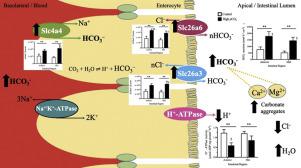Comparative Biochemistry and Physiology A: Molecular & Integrative Physiology ( IF 2.3 ) Pub Date : 2020-08-15 , DOI: 10.1016/j.cbpa.2020.110789 Alexandra Alves 1 , Sílvia F Gregório 1 , Ignacio Ruiz-Jarabo 1 , Juan Fuentes 1

|
The intestine of marine fishes contributes to the ocean carbon cycle producing carbonate aggregates as part of the osmoregulatory process. Therefore, this study aimed to evaluate physiological adjustments of European sea bass (Dicentrarchus labrax) intestine to a higher pCO2 environment likely in the near future (~1700 μatm). At the whole-body level, hypercapnia for 5 weeks resulted in fish having a significantly diminished specific growth rate, condition factor and hepatosomatic index. An increase in plasma osmolality and HCO3− concentration was detected, paralleled by decreased metabolites concentrations. In the intestine, high seawater pCO2 was without effect on ouabain-sensitive ATPase activities, while Bafilomycin A1-sensitive ATPase activity significantly decreased in the anterior intestine. Anterior and mid intestine were mounted in Ussing chambers in order to measure bioelectrical parameters and bicarbonate secretion by pH-Stat ex-vivo. Hypercapnia induced a 2.3 and 2.8-fold increase in bicarbonate secretion rates in the anterior and mid intestine, respectively. In the intestinal fluid, HCO3− concentration increased 2.2-fold, and carbonate precipitates showed a 4.4-fold increase in response to hypercapnia, paralleled by a >3-fold increase of drinking and a >2-fold increase of intestinal volume at any given time. At the molecular level, hypercapnia elicited higher intestinal mRNA expression levels for atp6v1b (V-ATPase B subunit), slc4a4, slc26a3, and slc26a6, both in the anterior and mid intestine. As a whole, our results show that the intestine of sea bass responds to high seawater pCO2, a response that comes at a cost at the whole-body level with an impact in the fish specific growth rate, condition factor, and hepatosomatic index.
中文翻译:

肠道对欧洲鲈鱼(Dicentrarchus labrax)中海洋酸化的反应。
海洋鱼类的肠道有助于海洋碳循环,产生碳酸盐聚集体,这是渗透调节过程的一部分。因此,本研究旨在评估欧洲鲈鱼(Dicentrarchus labrax)肠道在不久的将来(〜1700μatm)的较高p CO 2环境的生理调节。在全身水平,高碳酸血症持续5周导致鱼类的比生长速率,条件因子和肝体指数显着降低。血浆渗透压和HCO增加3 -检测浓度,通过降低代谢物浓度平行。在肠道中,高海水p CO 2对哇巴因敏感性ATP酶活性没有影响,而Bafilomycin A1敏感性ATP酶活性在前肠中显着降低。将前肠和中肠安装在Usssing室中,以通过体外pH-Stat测量生物电参数和碳酸氢盐分泌。高碳酸血症分别导致前肠和中肠的碳酸氢盐分泌率分别增加2.3和2.8倍。在肠液,HCO 3 -浓度增加2.2倍,和碳酸盐的沉淀物显示出响应于高碳酸血症4.4倍的增长,通过饮用的>增加3倍,并在任何肠体积的> 2-倍增加并联给定时间。在分子水平上,高碳酸血症引起更高的肠道mRNA表达水平atp6v1b(V-ATPase B亚基),slc4a4,slc26a3和slc26a6都位于前肠和中肠。总体而言,我们的结果表明,鲈鱼的肠道对高海水p CO 2有反应,这种反应是以全身水平为代价的,对鱼的特定生长率,条件因子和肝体指数有影响。


























 京公网安备 11010802027423号
京公网安备 11010802027423号